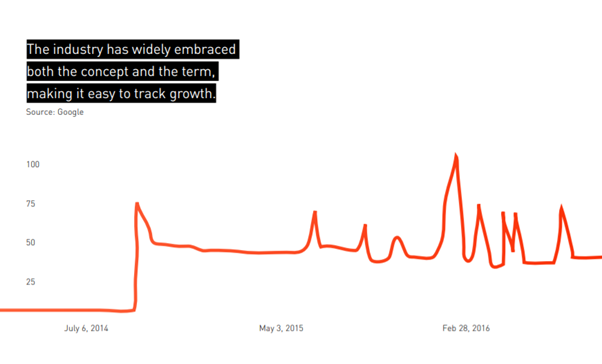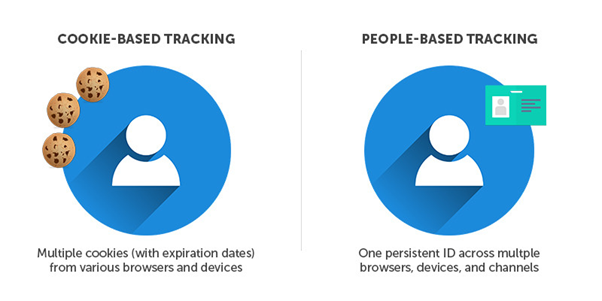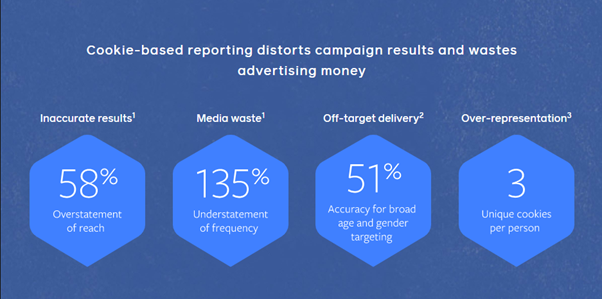Devices are everywhere. You have a phone. You have a smart TV. You have a smart speaker. Your smart speaker has a phone. That phone has a phone. And you're all shopping. It's perfect for marketers.

People-based marketing is taking a pretty personal approach. When using it, brands can customise messaging, customer experience, and deliver campaigns at just the right time. Every customer is an individual, and unique, target.
In fact, 95% of companies surveyed were already running people-based marketing campaigns on social channels, and 90% of respondents saw "improved performance" when implementing the technique. So, hold up. Let's get into the straight forward definition.
What is People-based Marketing?
Also called 'cross-device marketing', people-based marketing uses technology to market to clients across all the channels they use. Then, targeted ads are delivered on all these different devices and platforms, based on the individual's behaviour. Remember, nearly 60% of shoppers who have experienced personalisation believe that it played a role in the final purchase decision.
So, most marketers refer to it as 'people-based', to emphasise the person behind the whole thing.
Think targeting people, not devices.
Basically, this whole thing has sprung from the changing viewing and shopping habits of consumers. According to the Consumer Technology Association, 50% of people in the United States use a second screen when watching television. You know what it's like, look down at your phone for half a second, look back up, half of the characters are dead. Time to rewind. 🙄📱 📺
Information tied to identity is the basis of people-based marketing - with this technique, marketers are offered better targeting solutions but also more opportunities to enhance trust with both the client and the consumer"
Richard Lees, Chief Strategy Officer EMEA at Merkle
According to Facebook for Business, marketers don't hold anything fixed and constant with people-based marketing. It's all about focusing on the person, rather than large, nebulous groups such as "Fans of Nickelback", "UFC viewers" or "Men aged 45-60". Though those tend to be the same people. Instead, you'll reach each individual, as an individual, on their individual devices. Individually.
So, people-based marketing fills in the gaps in your data. It uses the data from your CRM platform, and connects it with their collective online identity.

"Because today, reach and attention is fragmented across devices and platforms" reports the social media site.
"Every one of these variables will change with every exposure, and planning for people for where they are will allow marketers to efficiently achieve and scale the goal of showing the right advert, to the right person, at the right time."
So, what should you consider when implementing people-based marketing?
Well, keep an eye on:
- Cross-device ID. Mobile devices are the biggest fragment-er of them all. To the point where 56% of marketers plan to increase spending on cross-device campaigns in 2017, another 33% plan to maintain spending at current levels.
- Geolocation. “Consumers are staying logged into apps that share their location data,” said Carla Rippon, a member of the IAB’s platforms group. “That’s a huge opportunity for marketers to harvest that location data and serve people ads for stores they’re close to or even visiting." By tracking this geolocation, marketers can send individuals targeted and relevant ads when they are near stores, where it is easier to convince them to purchase. Mobile device apps make this possible.
- Data Management Platforms. Marketers have to create a persistent ID for individual they want to target. This ID will be chock-full of data, including first party, which is then matched with info from third party sources that will fit the consumer. Then, marketers can shape a persistent ID that means they can follow the customer across all devices. This is all done within the data management platform.
…And why does it work?
In one word: personalisation.
96% of retailers agree that personalisation does influence purchase behaviour. 88% of marketers state they are seeing a clear improvement due to personalisation, with more than half reporting an improvement of more than 10%.
Traditionally, marketers have relied on cookies to target customers. These allow companies to keep an eye on what a user views on a website, then target them with relevant content on other sites. But now, this isn't enough.
“A cookie, in and of itself, isn’t the problem,” explains Experian.
“The problem is the linkage. How was a cookie associated with the person to whom the ad is being served? As marketers, we need to make sure that we are reaching the right people with the right ad, and more importantly not reaching those people who have opted out.”
Plus, according to Matt Naeger, who heads US strategy for Merkle, marketers shouldn't put all their (chocolate) chips on cookies.
“We became a little bit dependent on third-party cookies because it was easier, faster, and required less planning and integration [than traditional marketing],”
People-based marketing and GDPR
People-based marketing is going to prove vital now GDPR is in effect. This will require companies to gain full consent from customers, before collecting their information.
A people-based approach, utilising insight to personalise messages and frequency, will be key in gaining trust, and as a result, consent. So, this means the business is focusing on the needs and wants of the customer, rather than just chucking irrelevant messaging at them until they cave.
GDPR also means brands will have to focus more heavily on first-party data. Basically, first-party data is collected from your own personal sources, and is often the most valuable. It's pretty easy to collect and manage, especially if you have a data management system.
The accuracy of first-party data makes it possible to produce reliable models based on client behaviour. Even with a small data set, there's going to be some valuable insights.
What is the industry response?
Facebook is promoting people-based marketing as a driver of direct response; from app downloads, to mailing lists, and loyalty campaigns.
"People-based marketing allows marketers to plan for reach and frequency hand-in-hand, with the added ability to activate that plan with the same level of control. Our measurement methods have helped us develop a good understanding of how different reach and frequency strategies can be used to achieve business objectives. And, of course, planning, buying and measurement can all happen within one space on [digital] platforms"
Kumi Harischandra, Quantitative Researcher at Facebook
Yet, 33% of buyers said clients most often used people-based marketing for brand campaigns, with loyalty and retention following with 31%. Then came cross-selling, customer acquisition and reactivation campaigns.
But people-based marketing has been growing as a whole since its introduction. 48% of media buyers surveyed reported that spending on campaigns have been growing quickly. Another 44% stated that it is growing steadily. Only 7% of respondents reported no change at all.
Like every type of digital advertising that came before it, and is to come, it would be impossible without the invention and introduction of new technologies. In the case of people-based marketing, it's goliaths like Facebook and Google which facilitated the process. These platforms allowed for direct targeting of verified individuals.
This is alongside mobile technologies extending campaigns beyond traditional television and desktop computer screens to create overarching messaging. Plus, you can't forget about the DMPs.

Advantages (and Challenges) of People-based Marketing
So, we've had a look into the advantages of people-based marketing. But here's a nice little list:
- Improved personalisation
- Reduced wastage on ad spend
- Increased ROI
- A better understanding of customers
- Expanded reach
- Increased customer trust
But the challenges need a deeper look into. These can include issues with:
- Data acquisition. Third-party data has always been the industry darling, with marketers utilising a varieties of tactics to get their hands on it. That might be cookies, tracking pixels, other proxy tools etc. etc. But first-party data is harder to gather, outside the walled gardens of Facebook and Google. Outside these platforms, it's hard to launch a people-based marketing campaign without a good well of first-party data.
- Privacy. Alongside data-heavy campaigns and practises always appears its bedfellow privacy. Customers love a personalised experience, but are hesitant to share identifiable personal information with digital platforms.
80% of consumers say they are comfortable with sharing their personal info directly with a brand if it leads to a personalised marketing message. However, 63% say they think most companies aren't transparent enough with how their data is used, and 54% say it's actually harder than ever for companies to earn their trust.
The growth of tactics like geolocation, that people-based marketing relies on, have been slowed by these concerns. But with the younger generations, who are more tech-aware, comes the willingness to share this data in order to get benefits in return.




